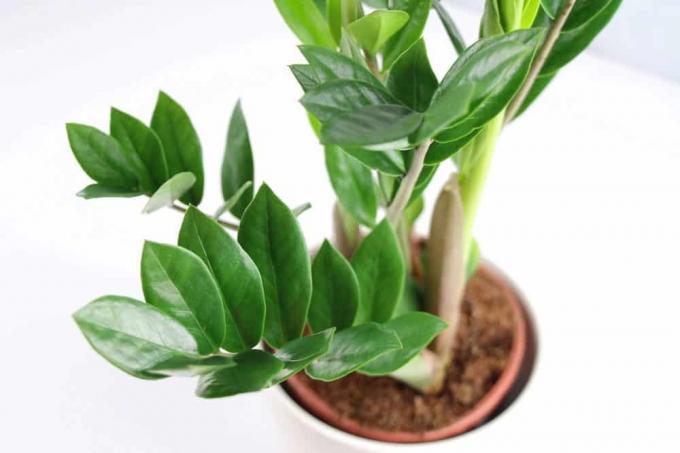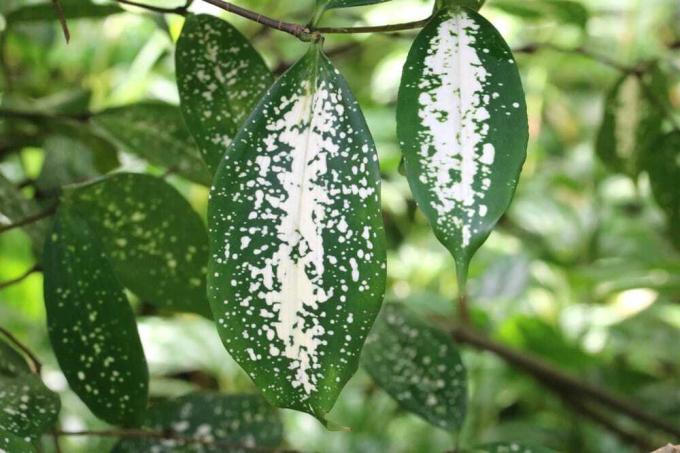

Table of contents
- The toxicity
- The cultivation
- The site
- The potting soil
- Watering and fertilizing
- The rest period
- The repotting and sharing
- Propagation with leaf cuttings
- plant pests
The Zamioculcas, which belongs to the arum family, is a welcome ornamental leaf plant in the living room. It does not require much care and is therefore also suitable for inexperienced indoor gardeners. In the right location and with the right soil, it can grow up to 90 cm high and therefore needs a little space on the windowsill.
The toxicity
As an arum plant, the Zamioculcas belongs to the poisonous plants and a certain amount of caution is therefore required. The plant contains oxalic acid and calcium oxalate, which is also present in the water that may collect in the planter. Pets should not be able to drink from it. Curious small children should also not be allowed near the plant, although life-threatening poisoning from the toxins of the lucky feather is not known.
The following symptoms of poisoning can occur:
- Redness and swelling on contact with skin and mucous membranes
- burning sensation on the skin after contact
- Difficulty swallowing when taking parts of plants through the mouth
- If parts are swallowed, gastrointestinal symptoms such as diarrhea and vomiting occur
- By eating parts of the Zamie, the calcium level in the blood serum can drop, and damage to the kidneys is also possible
Treatment by a doctor is only necessary in rare cases, because children and animals usually spit out the bitter leaves immediately.
The following first aid measures are recommended:
- Eye wash if plant sap has penetrated
- if parts of the plant are swallowed, drink a lot, the large amount of liquid dilutes the poison
- Visit a doctor if there is no improvement in the short term

Animals that come into contact with the lucky feather or eat parts of it show the same symptoms as humans. Here, too, the veterinarian should be consulted if the symptoms of poisoning do not improve after a short time.
Tip:
Wear gloves when handling the Zamioculcas. This way the skin cannot be irritated. Work with the necessary caution.
The cultivation
Only one leaf with seven to fourteen leaflets sprout from bulbous rhizomes lying underground. Here the lucky spring stores water for dry periods. Flowers are rare in the Zamie. However, once a flower develops, a white spadix, similar to that of the aroid, sprout from a bract.
The site
A spot in the partial shade, where the midday sun cannot reach them, is just perfect for the Zamioculcas. It is content with a little morning or evening sun to thrive magnificently. She can't stand the blazing sun. Therefore, a very sunny location should be shaded with a cloth or something similar. If the Zamie is in direct shade, slower growth and a darker green color of the leaves are observed.
However, the lucky feather is not damaged in such a place. In order for her to feel comfortable in her environment, the room temperature should be between 18 and 25 degrees. Only in autumn and during winter, when the plant is going through its dormant period, can it be a little cooler, but the temperature should not fall below 16 degrees.
The potting soil
A Zamie is ideally planted in loose potting soil that has been enriched with compost. The soil must be well drained and only have a maximum pH of 6.5. A little sand, loam or clay granules in the potting soil has a positive effect on the growth of the lucky feather. These additives prevent waterlogging and keep the potting soil loose and permeable. If you don't want to mix it yourself, cultivate the Zamie in special palm soil, because potting soil from the supermarket molds quickly.
Watering and fertilizing

The easy-care Zamioculcas zamiifolia is content with small but regular watering. The surface of the soil in the flower pot can dry out a little before the next dose. Beginners in indoor gardening sometimes forget to water. This is not tragic with the Glücksfeder. Thanks to its fleshy rhizomes, where it stores the water, it can survive a "dry season" unscathed. However, waterlogging should be avoided in any case.
If the Zamie is too wet, its leaves turn yellow and its individual stems can rot. Zamioculcas zamiifolia has relatively low nutritional requirements. In the spring, when the plant sprout again, you can supply it with a normal liquid fertilizer every four weeks.
The rest period
From late autumn, the zamie enters a dormant period. It now needs cooler temperatures and less water. In the bedroom, with sufficient light and a room temperature that is not below 16 degrees, she feels comfortable. The top third of your soil ball can safely dry out before the next watering. However, if the lucky feather gets too dry, it sheds its feather leaves. New shoots will not form until next spring. Fertilizers can be completely dispensed with during the resting phase.
The repotting and sharing
When the lucky feather has completely filled its pot with rhizomes, it is time to give it a new planter with fresh soil. The best time for this is March or April, when the plant sprout again. If you want, you can now share the Zamie. Carefully cut them into two or three sections with a sharp, clean knife, remove the old soil, and replant each plant in fresh, compost-rich potting soil.
Propagation with leaf cuttings

When repotting, the plant can be propagated at the same time. Leaf cuttings can be cut from the mother plant. Individual leaflets are carefully separated, placed vertically in nutrient-rich soil and watered moderately. After several months, new rhizomes will develop in the soil and fresh shoots from them.
propagation step by step
- choose a healthy leaflet
- carefully cut off with a sharp knife
- Provide a container with potting soil
- Put the leaf in the ground with the cut edge first (1 cm deep)
- pour on
- Place the cuttings in the semi-shade at a room temperature of about 22 degrees
- regular watering
plant pests
The spider mite
If the lucky feather is in a room with dry and very warm heating air, it can happen that spider mites settle, especially in the winter months. An infestation is easy to recognize by the fine cobwebs between the leaf axils and pinnate leaves. The plant must now be quarantined immediately so as not to infect other indoor plants. Spider mites are controlled with commercially available insecticides for watering or spraying.
Tip:
If you want to do without chemicals, you can drive away the spider mites with an old household remedy. The zamie is first showered and then wrapped in a clear foil or bag that is sealed airtight. The foil can be removed after a few days and the spider mites will then have died.
The Red Spider
If a fine web appears on the leaves of the lucky feather and the leaves turn yellow, grey-green or even reddish-brown, there is an infestation with the red spider. To combat the unwanted insect, the plant is first given a thorough shower, including the underside of the leaves. Then the zamie must be sprayed with a suitable pesticide. If you don't want to spray, use a systemic control agent that is added to the irrigation water.
The plant absorbs the active ingredients through the roots with the water. In this way, the insecticide is distributed throughout the plant. All sucking pests are reached in this way, they die. Depending on the infestation, the procedure must be repeated several times.
 Home editorial office
Home editorial office
Learn more about indoor plant dictionary

Ornamental asparagus, Asparagus densiflorus: Care from A - Z
Ornamental asparagus is a popular decoration for the garden or balcony. The following guide with tips for care from A to Z shows how Asparagus densiflorus and other species of the plant such as Asparagus plumosus or Asparagus sprengeri can be cultivated.

Easy-care office plants - 18 plants for the office
If you have the opportunity to make your office a little more personal, you often use office plants because they have several good properties. You can find out which indoor plants are suitable here.

20 plants for children's rooms: non-toxic and easy to care for
Decorative plants are part of the design of the children's room. Plants in their own room give the offspring a comprehensive insight into the care of the plants, even if they are easy to care for. It is important when choosing plants that you choose non-toxic species.

Pruning & branching Money Tree, Crassula ovata
The money tree proves to be well tolerated by pruning. With targeted cuts, it can be raised to become a standard tree or formed into a bonsai. There are no limits for your creativity. The plant tolerates rejuvenation cuts as well as educational cuts or the radical removal of all shoots.

Dragon Tree, Dracaena surculosa: Care A – Z
Dracaena surculosa is a species of dragon tree popular for its fresh green and brightly mottled leaves. In contrast to the typical dragon tree, this one is more reminiscent of a bamboo because of its thin, branched stalks. But that is exactly what makes it so decorative.

10 useful indoor plants for a healthy indoor climate
Indoor plants transform a room into an oasis of well-being. They are decorative and healthy at the same time. They help to improve the room climate by reducing the concentration of carbon dioxide, optimizing the air humidity and binding pollutants from furniture and carpets. Which houseplants are recommended?

